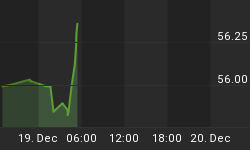May was the month when investors rediscovered both the beauty and the reality of commodity investing. With the fantasy of deflation fading into the background under the deluge of fiat credit by central banks, and in particular the Federal Reserve, commodity prices have been reborn. That renewal of investor interest was fueled by two factors. First, the Obama Regime's wealth confiscation is to be accompanied by massive political patronage requiring the Federal Reserve to monetize some two trillion dollars more in debt. Second, that the center of the economic world is not an economy with two bankrupt auto companies and disabled banks, but rather is in Asia where China is creating massive amounts of wealth.

Our fist chart this week, above, shows the price performance of the important Agri-Food commodities thus far this year. Clearly, the winners have been oil, both palm and crude. The mean, or average, of price changes for Agri-Food commodities has substantially exceeded that of the S&P 500, and nearly matched that of Gold. The structural demand situation for Agri-Food commodities is reasserting itself, overcoming the hedge fund induced sell off.
We have talked previously of the global shortage of sugar that has sent that price soaring. Perhaps less well known is the growing shortage of soybeans. For those on the Street, soybeans are grown in a field, not produced in a factory. Soybeans are one of those Agri-Food commodities not readily observable by the average consumer. But, it represents the second most important vegetable oil consumed. Chinese importation of soybeans continues to set monthly records.
As we said, those soybeans are grown in a field, primarily in the U.S., Argentina, and Brazil. The old crop, that which was harvested in the Fall of 2008, is the old crop, and it represents all that is currently available. The new crop will not be harvested till this coming Fall. Anyway, demand is so high for soybeans that old crop ending stocks will be at a record low. The world may be moving into an era of soybean shortages. In what then will your potatoes and chicken sandwiches be fried?
While some, particularly state officials of California, prefer to pay foreign despots, like Chavez, for petroleum with which to make gasoline rather than an Iowa farmer for corn, biofuels are a reality of the modern world. Corn ethanol may indeed be only the first step for biofuels. Whatever, the demand for corn will grow not only for ethanol, but as animal feed to provide for the growing demand for meat in expanding Asian economies. U.S. ending stocks of corn are likely to also move to a new low. Corn is another symbol of the demise of the era of Agri-Food bounty.

Agri-Food Stock Index does not represent actual trades,
but is a model portfolio of Agri-Food stocks.
While much of the business media has been diverting your attention with continuous drivel on autos and banks, Agri-Food investors have been busy with more productive activities. As shown in above chart, Agri-Food stocks, as a group and on average, have almost doubled. This group of stocks, rather than simply bouncing off lows as is the case with the general stock market, has developed strong performance.
This recent performance may have been too strong. That is said despite the continuing strong fundamentals for the companies as a group. Should a correction develop in this group of stocks this Summer, investors would be given another opportunity to invest in these companies at perhaps attractive prices. Now is the time for investors to be doing their homework on the Agri-Food industry to take advantage of the next correction.
Gold has defended well the wealth of investors for more than a decade. Given the wealth destroying tendencies of governments in countries such as the U.S. and UK, Gold has a permanent role in portfolios. While defending your wealth is essential, we continue to argue that an offensive component to your portfolio may also be important. Agri-Food investments may be an offensive component that is being overlooked due to inadequate and narrow reporting in the popular business media. Read more at http://home.att.net/~nwschmidt/Order_AgriValueRECENT.html
AGRI-FOOD THOUGHTS is from Ned W. Schmidt,CFA,CEBS, publisher of The Agri-Food Value View, a monthly exploration of the Agri-Food grand cycle being created by China, India, and Eco-energy. To receive this publication, use this link: http://home.att.net/~nwschmidt/Order_AgriValue.html.
















